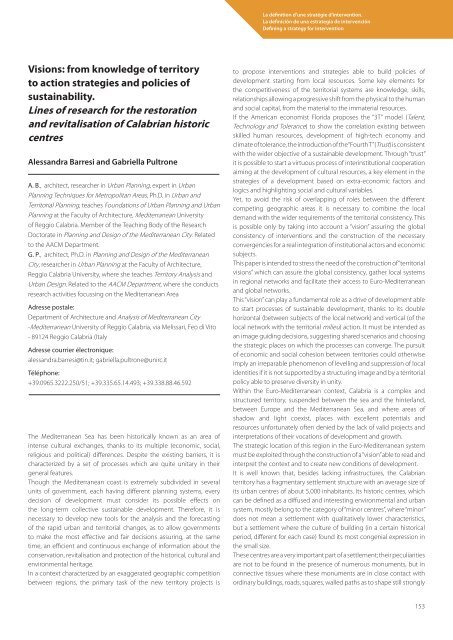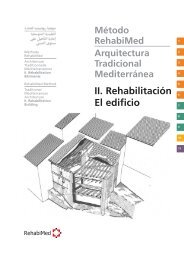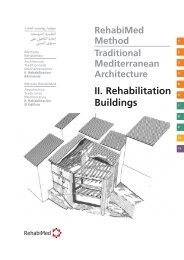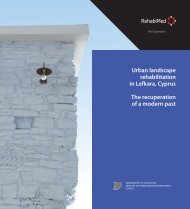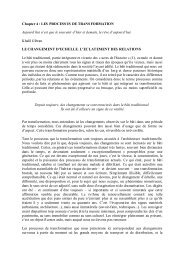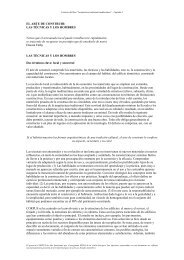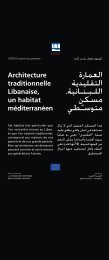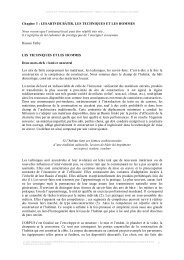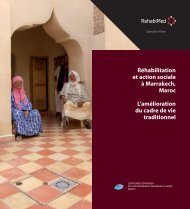La définition d'une stratégie d'intervention. La ... - RehabiMed
La définition d'une stratégie d'intervention. La ... - RehabiMed
La définition d'une stratégie d'intervention. La ... - RehabiMed
You also want an ePaper? Increase the reach of your titles
YUMPU automatically turns print PDFs into web optimized ePapers that Google loves.
<strong>La</strong> <strong>définition</strong> d’une <strong>stratégie</strong> d’intervention.<br />
<strong>La</strong> definición de una estrategia de intervención<br />
Defining a strategy for intervention<br />
Visions: from knowledge of territory<br />
to action strategies and policies of<br />
sustainability.<br />
Lines of research for the restoration<br />
and revitalisation of Calabrian historic<br />
centres<br />
Alessandra Barresi and Gabriella Pultrone<br />
A. B., architect, researcher in Urban Planning, expert in Urban<br />
Planning Techniques for Metropolitan Areas, Ph.D. in Urban and<br />
Territorial Planning, teaches Foundations of Urban Planning and Urban<br />
Planning at the Faculty of Architecture, Mediterranean University<br />
of Reggio Calabria. Member of the Teaching Body of the Research<br />
Doctorate in Planning and Design of the Mediterranean City. Related<br />
to the AACM Department.<br />
G. P., architect, Ph.D. in Planning and Design of the Mediterranean<br />
City, researcher in Urban Planning at the Faculty of Architecture,<br />
Reggio Calabria University, where she teaches Territory Analysis and<br />
Urban Design. Related to the AACM Department, where she conducts<br />
research activities focussing on the Mediterranean Area<br />
Adresse postale:<br />
Department of Architecture and Analysis of Mediterranean City<br />
-Mediterranean University of Reggio Calabria, via Melissari, Feo di Vito<br />
- 89124 Reggio Calabria (Italy<br />
Adresse courrier électronique:<br />
alessandra.barresi@tin.it; gabriella.pultrone@unirc.it<br />
Téléphone:<br />
+39.0965.3222.250/51; +39.335.65.14.493; +39.338.88.46.592<br />
The Mediterranean Sea has been historically known as an area of<br />
intense cultural exchanges, thanks to its multiple (economic, social,<br />
religious and political) differences. Despite the existing barriers, it is<br />
characterized by a set of processes which are quite unitary in their<br />
general features.<br />
Though the Mediterranean coast is extremely subdivided in several<br />
units of government, each having different planning systems, every<br />
decision of development must consider its possible effects on<br />
the long-term collective sustainable development. Therefore, it is<br />
necessary to develop new tools for the analysis and the forecasting<br />
of the rapid urban and territorial changes, as to allow governments<br />
to make the most effective and fair decisions assuring, at the same<br />
time, an efficient and continuous exchange of information about the<br />
conservation, revitalisation and protection of the historical, cultural and<br />
environmental heritage.<br />
In a context characterized by an exaggerated geographic competition<br />
between regions, the primary task of the new territory projects is<br />
to propose interventions and strategies able to build policies of<br />
development starting from local resources. Some key elements for<br />
the competitiveness of the territorial systems are knowledge, skills,<br />
relationships allowing a progressive shift from the physical to the human<br />
and social capital, from the material to the immaterial resources.<br />
If the American economist Florida proposes the “3T” model (Talent,<br />
Technology and Tolerance) to show the correlation existing between<br />
skilled human resources, development of high-tech economy and<br />
climate of tolerance, the introduction of the “Fourth T” (Trust) is consistent<br />
with the wider objective of a sustainable development. Through “trust”<br />
it is possible to start a virtuous process of interinstitutional cooperation<br />
aiming at the development of cultural resources, a key element in the<br />
strategies of a development based on extra-economic factors and<br />
logics and highlighting social and cultural variables.<br />
Yet, to avoid the risk of overlapping of roles between the different<br />
competing geographic areas it is necessary to combine the local<br />
demand with the wider requirements of the territorial consistency. This<br />
is possible only by taking into account a “vision” assuring the global<br />
consistency of interventions and the construction of the necessary<br />
convergencies for a real integration of institutional actors and economic<br />
subjects.<br />
This paper is intended to stress the need of the construction of “territorial<br />
visions” which can assure the global consistency, gather local systems<br />
in regional networks and facilitate their access to Euro-Mediterranean<br />
and global networks.<br />
This “vision” can play a fundamental role as a drive of development able<br />
to start processes of sustainable development, thanks to its double<br />
horizontal (between subjects of the local network) and vertical (of the<br />
local network with the territorial milieu) action. It must be intended as<br />
an image guiding decisions, suggesting shared scenarios and choosing<br />
the strategic places on which the processes can converge. The pursuit<br />
of economic and social cohesion between territories could otherwise<br />
imply an irreparable phenomenon of levelling and suppression of local<br />
identities if it is not supported by a structuring image and by a territorial<br />
policy able to preserve diversity in unity.<br />
Within the Euro-Mediterranean context, Calabria is a complex and<br />
structured territory, suspended between the sea and the hinterland,<br />
between Europe and the Mediterranean Sea, and where areas of<br />
shadow and light coexist, places with excellent potentials and<br />
resources unfortunately often denied by the lack of valid projects and<br />
interpretations of their vocations of development and growth.<br />
The strategic location of this region in the Euro-Mediterranean system<br />
must be exploited through the construction of a “vision” able to read and<br />
interpret the context and to create new conditions of development.<br />
It is well known that, besides lacking infrastructures, the Calabrian<br />
territory has a fragmentary settlement structure with an average size of<br />
its urban centres of about 5,000 inhabitants. Its historic centres, which<br />
can be defined as a diffused and interesting environmental and urban<br />
system, mostly belong to the category of “minor centres”, where “minor”<br />
does not mean a settlement with qualitatively lower characteristics,<br />
but a settlement where the culture of building (in a certain historical<br />
period, different for each case) found its most congenial expression in<br />
the small size.<br />
These centres are a very important part of a settlement; their peculiarities<br />
are not to be found in the presence of numerous monuments, but in<br />
connective tissues where these monuments are in close contact with<br />
ordinary buildings, roads, squares, walled paths as to shape still strongly<br />
153


